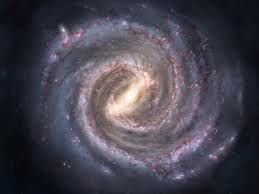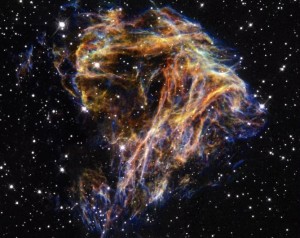May
25
Living on a Razor’s Edge (Part 2 of 3)
“Astronomy leads us to a unique event, a universe which was created out of nothing, one with the very delicate balance needed to provide exactly the conditions required to permit life, and one which has an underlying (one might say ‘supernatural’) plan.”
— Arno Penzias, physicist who shares the Nobel prize for physics for discovering the cosmic background radiation
The more astute of you will realize that this is now a 3-part rather than 2-part series. As I continued my reading/writing for this post, I realized that I had more that I wanted to include and that it was better to split it into two posts. But, I haven’t re-named the first post, ‘cuz I didn’t want to risk screwing up the linking. OK?
Onward…
While working on this particular post, I was reminded of the Search for Extra-Terrestrial Intelligence (SETI) program, as well as the general expectation by scientists and laypeople alike that there is intelligent life “out there” and we will eventually find it — possibly even make contact. It is an exciting prospect, and we are filled with wonder at what we might learn from such an encounter. (The assumption is usually that extraterrestrial beings will be much more culturally, perhaps “morally”, advanced than we are; I don’t know why, though.) But, as fascinating as that might be to think and talk about, I’m not nearly so optimistic. Actually, the more things we discover about this universe and the specialness of our location within it, the more rare Earth and life appear to be. One might even say “miraculous”.
Everybody knows that, astronomically speaking, we live in the Milky Way Galaxy. Very few, however, realize just how special that Milky Way is. It’s part of what’s called The Local Group of galaxies, which is in turn on the far outer edge of the Virgo Supercluster. Most galaxies are in dense bunches, so there are all kinds of collisions and mergers going on, not to mention lots of deadly radiation. But, the Milky Way’s location helps it to avoid most of that. In fact, it has just the right number and type of neighboring galaxies, which are at just the right distances and at just the right time, to allow formation of a particular kind of star around which life could exist and stay protected.
The Milky Way also happens to be one of those 5% of galaxies that are spirals. The other types — elliptical and irregular — have no chance of supporting life. Remember what I mentioned before about heavy elements (i.e., those with atomic weights heavier than helium) being necessary for life. (Kind of obvious, if you think about it.) Well, elliptical galaxies stop making stars before sufficient heavy elements can get spewed out into the medium and incorporated into later-forming star systems. Most small irregular galaxies have a similar problem. But, the main problem with irregulars is their active nuclei, which spit out all sorts of nasty radiation and other stuff.
So, if you wanna live, a spiral galaxy is the place to be. As mentioned, it has to be specifically situated in a “sweet spot”, too. (The formal term is “habitable zone”.) That just-right location is what allows the Milky Way to keep its spiral structure by pulling in goodly amounts of gas & dust from nearby dwarf galaxies. And the spiral structure is what allowed the Sun to form at the right time for life and keeps it in a safe orbit around the center of the galaxy. (More on this later.)
Supernovae are also both a danger and a necessity for life. A new star system needs access to sufficient heavy elements to both form “rocky” planets (like Earth) and support life chemistry. These heavy elements are produced in the hearts of stars and spewed out when they go novae or supernovae. The estimated rate of supernova eruptions needed to provide this material is about 1 every 3 years from the time the Milky Way itself originated (roughly 10 billion years ago). However, that rate must be relatively low in the present era in order to avoid regular exterminations by heavy radiation of whatever life may have appeared on Earth. Fortunately, the current rate is less than 1 every 50 years. Pretty amazing timing, especially when you consider that the frequency of supernovae is also dependent on location at the just right part of the galaxy, at a just right distance from a spiral arm, and at a just right distance from the center of the galaxy.
Our Sun is pretty special, too, for a number of reasons. Let’s stick with location, for now. It is located in between two spiral arms at the “corotation distance” relative to the center of our galaxy. This is extremely rare. Most stars are located in very dense regions, where planetary orbits would be disturbed by huge gravitational forces; and, if that doesn’t kill you, the intense radiation will. The Sun is also very rare in that it is situated at the “galactic corotation radius”, which allows it to remain between those spiral arms rather than be swept inside one or the other.
Want another one? Twice now, I’ve mentioned how the Sun maintains a safe orbit around the galactic center. Unlike most stars, which display a lot of movement (up-n-down, side-to-side, back-n-forth), the Sun rarely deviates from its circular orbit. The tiny bit of up-n-down that it exhibits reduces the radiation we get from the aforementioned supernovae remnants and the galactic nucleus. The relatively minute amount of back-n-forth & side-to-side we see helps keep us from getting too close to a spiral arm.
Not surprisingly, life also requires a single-star system. Two or more stars result in an unstable orbit, as well as radiation and temperature extremes that would not be survivable. (Though, in science-fiction, they sure do make for beautiful sunrises and sunsets.) On the other hand, a rogue planet without a star would be waaaay too cold, among other things. The star’s mass must be within a specific range to support life, too. A little bigger than our Sun and it will burn too quickly and erratically. Not good. A little less massive than our Sun and you get more frequent and violent flaring. Also, not good. Furthermore, the smaller the mass of the parent star, the closer the planet needs to get to maintain the necessary temperature range for life. But, with every little bit a planet gets closer to its star, the tidal interaction between the two increases a lot. As with Venus and Mercury, the planet’s rotation period (i.e., “day”) quickly stretches from hours to months. (And you thought the six-month “days” and “nights” at our polar regions were uncomfortable…?)
Even the timing of the star’s formation is crucial. Either too soon or too late in the galaxy’s history means you won’t get the right mix of those ever-important heavy elements. This means that the star’s age is also significant. Only middle-aged stars (e.g., the Sun, ~4.6 billion years old) have reached, and are still in, a sufficiently stable burning phase. Heck, even the yellow color of our Sun is important for life, since if it was any redder or bluer, the photosynthetic response would be insufficient.
Alright, I guess that’s enough science to throw at you, for now. Don’t know about you, but I’m getting that “just right, Goldilocks” kind of feeling….


















